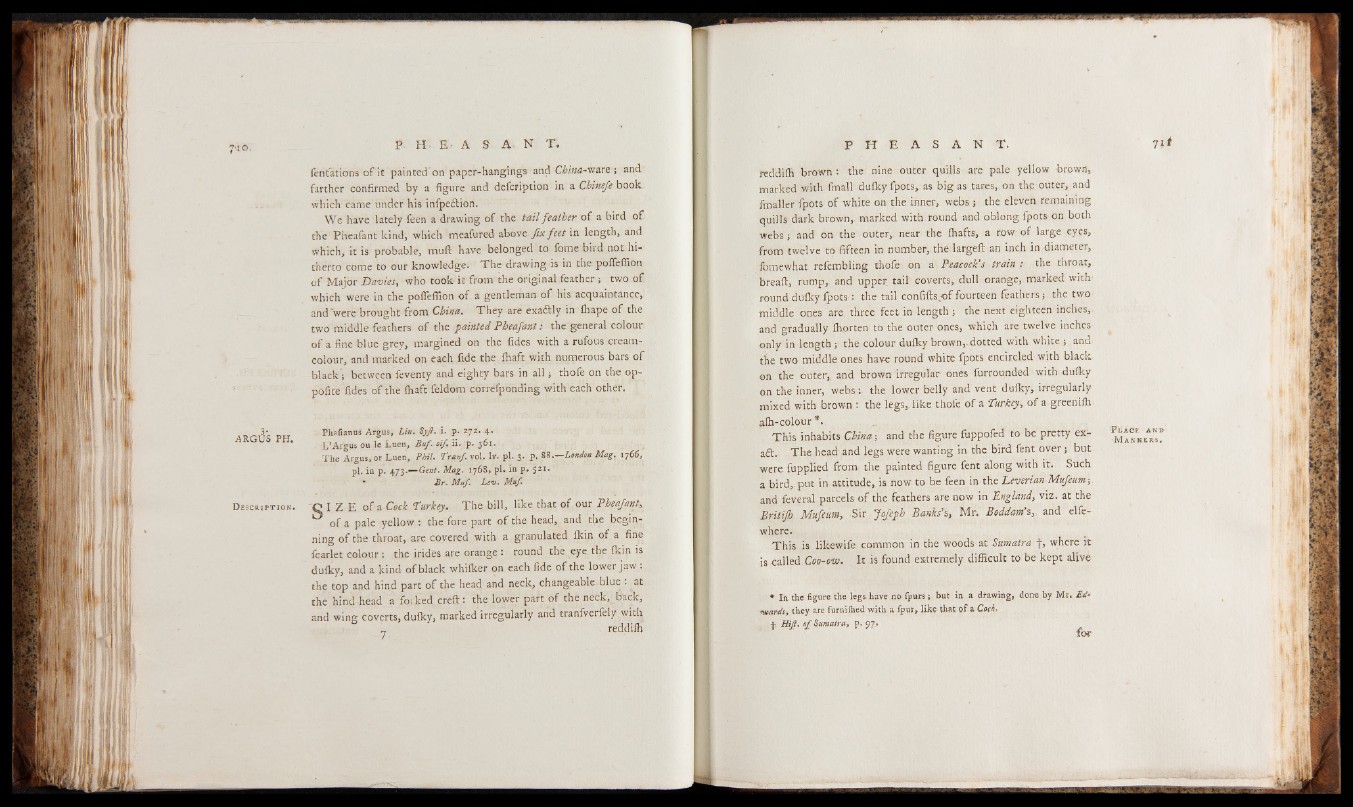
fenfations of it painted'on paper-hangings and China-ware ; and
farther confirmed by a figure and defcription in a Chinefe book
which came under his infpection.
We have lately feen a drawing of the tail feather of a bird of
the Pheafant kind, which meafured above fix feet in length, and
which, it is probable, muft have belonged to fome bird not hitherto
come to our knowledge. The drawing is in the pofiefiion
of Major Davies, who took it from the original feather; two of
which were in the pofiefiion of a gentleman of his acquaintance,
and 'were brought from China. They are exa&ly in fhape of the
two middle feathers of the painted Pheafant: the general colour
of a fine blue grey, margined on the fides with a rufous cream-
colour, and marked on each fide the lhaft with numerous bars of
black’; between feventy and eighty bars in a ll; thofe on the op-
pofite fides of the fliaft feldom correfponding with each other.
3- Phaiianus Argus, Lin. Syjt. i. p. 272.4.
* L ’Argus ou le Luen, Buf oif. ii. p. 361.
Tile Argus, or Luen, Phil. Tran/, vol. lv. pi. 3. p. 88.—London Mag. 1766,
pi. in p. 473.— Gent. Mag. 176S, pi. in p. 521.
• Br. Muf. Lent. Muf
D escription, q I Z E of a Coek ‘tu r k e y . The bill, like that of our P h e a fa n t>
^ of a pale yellow: the fore part of the head, and the beginning
of the throat, are covered with a granulated Ikin of a fine
fearlet colour: the irides are orange : round the eye the Ikin is
dulky, and a kind of black whilker on each fide of the lower jaw .
the top and hind part of the head and neck, changeable blue . at
the hind head a foiked creft: the lower part of the neck, back,
and wing coverts, dulky, marked irregularly and tranfverfely with
y ■ reddilh
reddilh brown : the nine outer quills are pale yellow brown,
marked with fmall dulky fpots, as big as tares,,on the outer, and
fmaller fpots of white on the inner, webs ; the eleven remaining
quills dark brown, marked with round and oblong fpots on both
webs; and on the outer,, near the fhafts, a row of large eyes,
from twelve to fifteen in number,the largefl; an inch in diameter,,
fomewhat refembling thofe on a Peacock’s train :■ the throat,
bread, rump, and upper tail coverts, dull orange, marked with'
round dulky fpots : the tail confiftsjof fourteen feathers;, the two
middle ones are three feet, in length; the next eighteen inches,
and gradually Ihorten to the outer ones, whiqh are twelve inches
only in length ; the colour dulky brown, dotted with white ; and
the two middle ones have round white fpots encircled with black
on the outer, and brown irregular ones furrounded with dulky
on the inner, webs :, the lower belly and vent dulky, irregularly
mixed with brown : the legs, like thofe of a turkey, of a greenilh
a!h-colour *.
This inhabits China-, and the figure fuppofed to be pretty exaft.
The head and legs were wanting in the bird fent o v er; but
were fupplied from the painted figure fent along with it. Such
a bird, put in attitude, is now to be feen in the Leverian Mufeum-,
and feveral parcels of the feathers are now in England, viz. at the
Britijh Mufeum, Sir Jofeph Banks’s, Mr. Boddam’s, and elfe-
where.
This is likewife common in the woods at Sumatra f , where it
is called Coo-ow. It is found extremely difficult to be kept alive
* Ih the figure the legs, have no fpurs; but in a drawing, done by Mr. Ed•
wardsy they are furnifhed with a fpur, like that of a Cock,
+, Hiß, ofj Sumatra, p. 97.. for
Place
-Mann